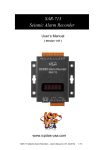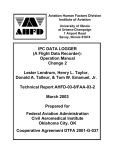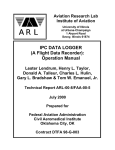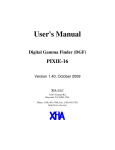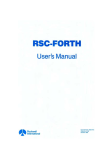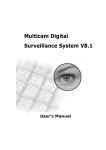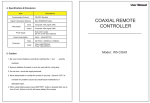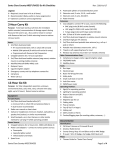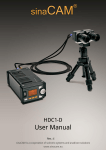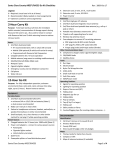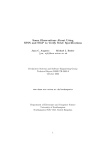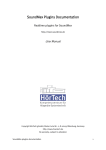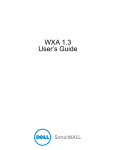Download Seismic Alarm Recorder SAR-713
Transcript
SAR-713 Seismic Alarm Recorder User’s Manual ( Version 1.04 ) SAR-713 (Seismic Alarm Recorder) – User’s Manual (v1.04, July/2012) 1 / 74 Warranty All products manufactured by ICPDAS Inc. are warranted against defective materials for a period of one year from the date of delivery to the original purchaser. Warning ICPDAS Inc. assumes no liability for damages consequent to the use of this product. ICPDAS Inc. reserves the right to change this manual at any time without notice. The information furnished by ICPDAS Inc. is believed to be accurate and reliable. However, no responsibility is assumed by ICPDAS Inc. for its use, or for any infringements of patents or other rights of third parties resulting from its use. Copyright Copyright 2010 by ICPDAS Inc., LTD. All rights reserved worldwide. Trademark The user can use, modify and backup this software on a single machine. The user may not reproduce, transfer or distribute this software, or any copy, in whole or in part. SAR-713 (Seismic Alarm Recorder) – User’s Manual (v1.04, July/2012) 2 / 74 Table of Contents 1. Introduction: ................................................................................................. 6 1.1 Features: ............................................................................................ 7 1.2 Specificatoin: ...................................................................................... 7 2. Application Architecture:............................................................................. 10 3. Wiring:.........................................................................................................11 3.1 Information for Power LED .................................................................. 12 3.2 Information for 7-Segment LED Display .............................................. 12 3.3 Digital Inputs (DIs) Configuration ........................................................ 13 3.4 Parameters for Autoexec.bat............................................................... 13 3.5 DOs Wiring and Characteristics .......................................................... 14 3.6 DIs Wiring............................................................................................ 14 4. Parameters Setting: ................................................................................... 15 4.1 Initial Setting :...................................................................................... 15 4.2 Modbus Table : ................................................................................... 16 4.3 Parameter Description......................................................................... 21 ※ Addr 000:NTP / TCP Server Connection Flag ......................... 21 ※ Addr 001:Real-Time X-Axis Acceleration................................. 21 ※ Addr 002:Real-Time Y-Axis Acceleration................................. 21 ※ Addr 003:Real-Time Z-Axis Acceleration ................................. 21 ※ Addr 004:Real-Time Vector Acceleration................................. 22 ※ Addr 005:X-Axis Offset ............................................................ 22 ※ Addr 006:Y-Axis Offset ............................................................ 22 ※ Addr 007:Z-Axis Offset............................................................. 22 ※ Addr 008:The Max Acceleratoin in Earthquake........................ 22 ※ Addr 009:Real-Time earthquake Intensity................................ 23 ※ Addr 010:Max Intensity of the last Earthquake ........................ 23 ※ Addr 011:Earthquake Event Flag ............................................. 23 ※ Addr 012:LTA Ready Flag ....................................................... 23 ※ Addr 013:EEPROM Data Reocrd Flag..................................... 24 ※ Addr 014:Time Zone ................................................................ 24 ※ Addr 015:STA Duration............................................................ 24 ※ Addr 016:LTA Duration ............................................................ 25 ※ Addr 017:Earthquake Thresold in STA/LTA ............................. 25 ※ Addr 018:Operation Mode Setting............................................ 25 ※ Addr 019:DI / DO Status .......................................................... 27 SAR-713 (Seismic Alarm Recorder) – User’s Manual (v1.04, July/2012) 3 / 74 ※ Addr 020:Earthquake Event Duration ...................................... 27 ※ Addr 021:Earthquake Event Remaining Time .......................... 27 ※ Addr 022:Zero Offset Sample Number..................................... 28 ※ Addr 023 / 024:DO0/ DO1 Trig Value ...................................... 28 ※ Addr 025:Trig NTP Function .................................................... 28 ※ Addr 026:NTP Update Time Period ......................................... 28 ※ Addr 027:The Activated NTP Server No. ................................. 29 ※ Addr 028:Real-Time STA / LTA ............................................... 29 ※ Addr 029:Max Acceleration of X-Axis in Earthquake Event ..... 29 ※ Addr 030:Max Acceleration of Y-Axis in Earthquake Event ..... 29 ※ Addr 031:Max Acceleration of Z-Axis in Earthquake Event...... 29 ※ Addr 032:X-Axis Acceleration of Max Vector in Earthquake .... 29 ※ Addr 033:Y-Axis Acceleration of Max Vector in Earthquake .... 29 ※ Addr 034:Z-Axis Acceleration of Max Vector in Earthquake .... 30 ※ Addr 035 ~038:Data File Function of Earthquake Event .......... 30 ※ Addr 039:Streaming Data Control ............................................ 31 ※ Addr 040:Max STA/LTA in Earthquake Event .......................... 31 ※ Addr 041 ~ 046:Earthquake Event Time .................................. 32 ※ Addr 047 ~ 052:System Date / Time Information ..................... 32 ※ Addr 053 ~ 058:System Date / Time Setting............................ 32 ※ Addr 059 ~ 062:IP Address of NTP Server 2 Setting ............... 32 ※ Addr 063 / 064:Pre-Time / Post-Time Setting .......................... 32 ※ Addr 065 / 066:Counts and Total Counts of Earthquake Event 32 ※ Addr 067 ~ 069:Pulse Filter Value of 3-Axis Acceleration........ 33 ※ Addr 070:Pulse Filter Total Count of 3-Axis ............................. 33 ※ Addr 071 ~ 074:IP Address of NTP Server 1 Setting ............... 33 ※ Addr 075:System Time Information - Week ............................. 33 ※ Addr 076 ~ 079:Host MB/TCP Server IP Address Setting ....... 34 ※ Addr 080 ~ 091:SAR-713 Network Address Setting ................ 34 ※ Addr 092:Available MB/TCP Connections for Host .................. 34 ※ Addr 093:MB/TCP Client Update Period.................................. 34 ※ Addr 094:Modbus TCP/RTU Server Station No. Setting.......... 34 ※ Addr 095:Debug Message Enable Flag ................................... 34 ※ Addr 096:Remaining Time before Earthqauke Detection......... 35 ※ Addr 097:DHCP Client Function Status ................................... 35 ※ Addr 098:Axis-Mapping Setting................................................ 35 ※ Addr 099:SAR-713 Firmware Version...................................... 35 ※ Addr 100:SAR-713 Machine Serial Number ............................ 35 SAR-713 (Seismic Alarm Recorder) – User’s Manual (v1.04, July/2012) 4 / 74 ※ Addr 101 ~ 108:FilterIP Range Setting .................................... 35 ※ Addr 109:Extended Intensity Standard Option ......................... 36 ※ Addr 110:Extended Intensity Calcuation Mode Option............. 37 ※ Addr 111:Intensity Degree Value ............................................. 37 4.4. Modbus Function................................................................................ 38 4.5 SAR-713 Sequence............................................................................. 39 4.5.1. Boot Sequence...................................................................... 39 4.5.2. Earthquake Event Sequence................................................. 39 5. Software Utility: .......................................................................................... 40 5.1 Connection Function ........................................................................... 40 5.2 Module Configuration Function ........................................................... 43 5.3 TCP1500 Function .............................................................................. 45 5.4 EQFile_Info Function........................................................................... 51 5.5 Firmware Update................................................................................. 53 5.6 Stream Data ........................................................................................ 56 5.7 EQVoice File ....................................................................................... 58 6. TCP1500 Function: .................................................................................... 60 7. Factory Default Value:................................................................................ 61 7.1 Factory Default Value Table................................................................ 61 8. Direction Definition of X, Y, Z Axis:............................................................. 64 9. FAQ:........................................................................................................... 65 9.1 How to scan all SAR-713 modules in LAN ? ....................................... 65 9.2 Trend Update Pause Problem of SAR-713 Utility................................ 68 10. Version ....................................................................................................... 69 Appendix 1: Earthquake Intensity Table of Taiwan ........................................... 70 Appendix 2: Earthquake Intensity Table of China ............................................. 71 Appendix 3: Modified Mercalli Intensity Scale .................................................. 72 Appendix 4: JMA Intensity Scale ...................................................................... 73 Appendix 5 : Unit Conversion ........................................................................... 74 SAR-713 (Seismic Alarm Recorder) – User’s Manual (v1.04, July/2012) 5 / 74 1. Introduction: SAR-713 is an advanced technology seismic alarm recorder provided by ICP DAS with a tri-axial MEMS accelerometer and acquires vibration signal by 100Hz sampling rate. It can be used to establish a complete earthquake warning system to prevent any further significant damages caused by. SAR-713 adopts STA/LTA algorithm and supports dynamic zero offset calibration to detect earthquake. It is not only a seismic switch inclusive of 2 digital outputs for the security of facilities or staffs but also an earthquake data recorder for research analysis. It equips LED display which can real time show the maximum intensity according to CWB (Central Weather Bureau, Taiwan) or GB/T 17742-2008 (China) earthquake intensity standard, maximum vector, instant tri-axial acceleration, etc. SAR-713 supports NTP (Network Time Protocol) to keep internal clock on time and NTP server backup function for reliability of time accuracy. SAR-713 also supports host IP filter function to promote the security of network access. SAR-713 offers both MB/TCP and MB/RTU server for easily connection to host PC, PLC, HMI or SCADA. The connection number of MB/TCP host can be up to 10 simultaneously. It also provides active connection ability to MB/TCP server of host PC which is useful to deploy at environment without real IP. SAR-713 (Seismic Alarm Recorder) – User’s Manual (v1.04, July/2012) 6 / 74 1.1 Features: • • • • RoHS Design. Provide two digital outputs individually to protect crucial facilities. Support earthquake data file record function. Support NTP (Network Time Protocol) for time calibration to keep SAR-713 clock on time. • • • • • • • Support NTP backup server to promote time calibration reliability. Support IP filter function to promote the security of network access. Adopt STA/LTA algorithm and dynamic zero offset to detect earthquake. Support DHCP function Support MB/TCP and MB/RTU server function. Support MB/TCP client to connect to host MB/TCP server automatically. Support up to 10 MB/TCP client number simultaneously. • • • • • Support Taiwan / Japan / China / Modified Mercalli Intensity standard. Support module installation horizontally or vertically. Support firmware update via COM or Ethernet. Provide utility tool for real-time tri-axial acceleration trend and module setting. Watchdog inside. 1.2 Specificatoin: Items SAR-713 Accelerometer Type Tri-axial MEMS Range ±2g (X, Y Axes)、+1g/-3g (Z Axis) Frequency Response 0 ~ 40 Hz Shock 500g / 0.5 ms 3000g / 0.1 ms Digitizer ADC Resolution 12 bit Digital Resolution < 0.001 g Earthquake Gauge Algorithm STA/LTA STA Setting Range 0.01 ~ 60 Sec. SAR-713 (Seismic Alarm Recorder) – User’s Manual (v1.04, July/2012) 7 / 74 LTA Setting Range 0.01 ~ 60 Sec. Offset Period 0.01 ~ 655 Sec. Event Duration Time 0.01 ~ 60 Sec. Intensity Standard Support Taiwan / Japan / China / Modified Mercalli Intensity standard. Earthquake File Record Alarm Time Record Range 0.01 ~ 60 Sec. Pre-Time Record Range 0.01 ~ 10 Sec. Post-Time Record Range 0.01 ~ 10 Sec. Switch Setpoints Digital Output Numbers 2 Setport Range 2 ~ 1960 gal (cm/s2) Contact Type Normal Open Contact Capacity 0.6A DC Hold-On Time Same as Event or Duration Time Modbus Comm. Modbus/TCP Most 10 Host Simultaneously Modbus/RTU Default:1 (settable) ; Format:115200,N,8,1 Modbus Function Code Function Code : 1, 2, 3, 6, 16 Modbus Variables Address 000 ~ 108 LED Display 5-Digit 7 Segment LED Display Display Module and Earthquake Information System LED Indicator Display Module Power and Comm. Status Operating Environment Operating Temperature -25°C ~ +75°C Storage Temperature -40°C ~ +80°C Relative Humidity 5 ~ 90% RH, non-condensing Dimensions WxHxD 102 mm x 123 mm x 28 mm Weight 285g (Without Power and Cable) Power Protection Power reverse polarity protection SAR-713 (Seismic Alarm Recorder) – User’s Manual (v1.04, July/2012) 8 / 74 Frame Ground for ESD Protection Yes Required Supply Voltage +10 ~ +30 VDC (non-regulated) Power Consumption 3.5 W SAR-713 (Seismic Alarm Recorder) – User’s Manual (v1.04, July/2012) 9 / 74 2. Application Architecture: Modbus/TCP NTP Server PC or SCADA Internet Modbus/TCP HMI Relay Output RS-485 PC or SCADA SAR-713 Modbus/RTU Facilities Only one MB/RTU client can be connected HMI Wave SAR-713 (Seismic Alarm Recorder) – User’s Manual (v1.04, July/2012) 10 / 74 3. Wiring: Pins Description GND Power Ground +Vs Power Input : 10~30VDC 300mA D2- RS-485 D- of COM2 (Modbus RTU) D2+ RS-485 D+ of COM2 (Modbus RTU) INIT* Update firmware (No use when operaton) TXD1 TX of COM1 (Debug Port) RXD1 RX of COM1 (Debug Port) RTS1 RTS of COM1 CTS1 CTS of COM1 E1 Modbus TCP (10 / 100M Ethernet Port) DO0+ Relay Output 0+ (PhotoMOS Relay, Form A) Normal Open , 0.6A/60VDC DO0- Relay Output 0- (PhotoMOS Relay, Form A) Normal Open , 0.6A/60VDC DO1+ Relay Output 1+ (PhotoMOS Relay, Form A) Normal Open , 0.6A/60VDC DO1- Relay Output 1- (PhotoMOS Relay, Form A) Normal Open , 0.6A/60VDC DI0 Digital Input 0 (Show earthquake info when grounding.) DI1 Digital Input 1 (Recover to factory setting when DI-1 is grounding for 3 second continuously.) DI2 Digital Input 2 (Reserved) DI3 Digital Input 3 (Reserved) SAR-713 (Seismic Alarm Recorder) – User’s Manual (v1.04, July/2012) 11 / 74 3.1 Information for Power LED When SAR-713 powers on, the PWR LED will be on always. When Modbus communication (including MB/TCP and MB/RTU) starts, the PWR LED will flash. If Modbus communiation stoped, then the PWR LED will be on always. 3.2 Information for 7-Segment LED Display Normal Status: Display the below system information in order (When DI 0 isn’t grounding) (1) - - 1 - -:Show current IP Address of SAR-713 and format is as below. 1. 192 2. 168 3. 255 (IP1) (IP2) (IP3) 4. 1 (IP4) (2) - - 2 - -:Show current date and format is as below. 2010(Year) 10-13 (Month-Day) (3) - - 3 - -:Show current time and format is as below. 12-01 (Hour-Minute) 01.44 (Minute-Second) (4) - - 4 - -:Show earthquake event number and format is as below. 1.0001 2.0010 (Event number in this boot up => once) (Event total number => ten times) Earthquake Detected: Display the below information in order: (1) Intensity Standard : [1] ”-C01-“:CWB scale (Taiwan) [2] “-C02-“:GB/T 17742-2008 scale (China) [3] “-C03-“:Modified Mercalli scale. (America) => FW_v1.04 [4] ”-C04-“:JMA scale (Japan) => FW_v1.04 (2) Max Intensity : (Format : XXXXX) [1] Taiwan(CWB):Range from 0 to 7 (Ex: 66666 is intensity-6) [2] China(GB/T) :Range from 0 to 11 (Ex: AAAAA is intensity-10) [3] Mercalli :Range from 0 to 11 (Ex: A0001 is intensity-11) [4] Japan(JMA) :Range from 0 to 9 (Ex: 55555 is intensity-5 lower) (Ex: 66666 is intensity-5 upper) SAR-713 (Seismic Alarm Recorder) – User’s Manual (v1.04, July/2012) 12 / 74 (3) Max Acceleration : (Unit : gal) [1] Taiwan(CWB):z-axis or tri-axial vector or XY-axial vector. [2] China(GB/T) :horizontal axis (X and Y) vector. [3] Mercalli:z-axis or tri-axial vector or XY-axial vector. [4] Japan(JMA):z-axis or tri-axial vector or XY-axial vector. 3.3 Digital Inputs (DIs) Configuration [1] Display the last earthquake information:(DI-0) When DI-0 is grounding, the LED display will show the last earthquake information in order and the format is as below. (1) -C0x:Zone (”-C01-”:Taiwan ; ”-C02-”:China ; ”-C03-”:America ; ”-C04-”:Japan) (2) YYYY:Year (3) MM-DD (4) hh-mm (5) mm -ss (6) XXXXX :Month-Day :Hour-Minute :Minute-Second :Max Intensity (7) AA.AA :Taiwan: Max Acceleration(gal); China: Max Horizontal Acceleration(gal) If no any earthquake event happened after boot up, then the LED display will show ”0.0.0.0.0” message. [ Note ] (1) DI-0 will work when earthquake doesn’t happen. [2] Recover to factory setting:(DI-1) When DI-1 is grounding for 3 seconds continuously, SAR-713 will execute the factory default value recovery and then reboots. 3.4 Parameters for Autoexec.bat There is just one parameter is supported by SAR-713 as below. [Parameter 1]:DHCP Client Enable Ex1:SR713_10.exe => No any other extra function will be executed when SAR-713 boots up. Ex2:SR713_10.exe Y => DHCP client function will be executed when SAR-713 boots up. [ Note ] SAR-713 (Seismic Alarm Recorder) – User’s Manual (v1.04, July/2012) 13 / 74 (1) When DHCP client function executes failed, SAR-713 will adopt the original local IP address for default. 3.5 DOs Wiring and Characteristics DO is acted just like a switch with contact capacity as 60V 0.6A. Please refer to the below wiring diagram. 3.6 DIs Wiring Please refer to the below DI wiring diagram. SAR-713 (Seismic Alarm Recorder) – User’s Manual (v1.04, July/2012) 14 / 74 4. Parameters Setting: The parameters of SAR-713 have been set optimally for factory default. However, due to the different installation of location and signal noise, some adjustments for the parameters are necessary. In section 4.1, some basic and important parameters are described. In section 4.2, it is the Modbus table for all parameters. In section 4.3, it is the detailed description for all parameters. 4.1 Initial Setting : [1] IP/Mask/Gateway setting of SAR-713:(Addr: 080~091) Users need to set the IP/Mask/Gateway of SAR-713 according to the current network IP address range (Factory default value refers to chapter 7). If users want to use DHCP client function, please refer to section 3.4. [2] Installation of SAR-713:(Addr: 098) When users install SAR-713 horizentally, then the value of MB addr 098 should be set 0. If SAR-713 is installed vertically, then it should be set 1. If the value of MB addr 98 is set wrong, then the tri-axial direction will be wrong. After set the value of MB addr 098 correctly, the schematic diagram of the tri-axial direction refers to chapter 8. [3] Operation mode setting of SAR-713:(Addr: 018, 109, 110) The OP_Mode parameter must be set according to the application environment. The detailed description refers to MB addr 018. In FW_v1.04 or newer, add the “Extended Intensity Standard Option” in MB addr 109 and the “Extended Intensity Calcuation Mode Option” in MB addr 110. [4] Earthquake function setting: The related parameters need to be set according the application devices and environment and described as below. (1) “STA Time” / “LTA Time” / “STA/LTA Level” (Addr: 015~017) (2) Earthquake Alarm Time (Addr: 020) (3) Earthquake Pre-/Post- Record Time (Addr: 063~064) (4) DO0/1 Trigger Level (Addr: 023~024) => Factory default value refers to chapter 7. SAR-713 (Seismic Alarm Recorder) – User’s Manual (v1.04, July/2012) 15 / 74 [4] Time calibration Setting: This value of MB addr 014 needs to be set according to practical areas (Like: Taiwan is 8). Then set NTP Server IP in MB addr 071~074 and 059~063. At last, set the bit-4 of MB addr 018 to be 1 to enable NTP function. 4.2 Modbus Table : The Modbus registers from 40001 ~ 40111 are used by SAR-713, 40112 ~ are reserved. In the below table, the “Addr Offset” value is the offset from 40001. In R/W field,R means “Read Only”, W means “Write Only” and RW means “Readable and Writable”. “Label” is the variable name and “Description” is the function description. (EQ means Earthquake) SAR-713 Modbus Table (40XXX) Addr Addr Offset Offset R/W (DEC) (HEX) Label Description 000 0x00 R SvrConn_Flag NTP/TCP Server Connection Flag 001 0x01 R X_Acc Real-Time X-axis Acceleration 002 0x02 R Y_Acc Real-Time Y-axis Acceleration 003 0x03 R Z_Acc Real-Time Z-axis Acceleration 004 0x04 R Vec_Acc Real-Time 3-axial Vector Acc. 005 0x05 R X_Acc_Offset X-axis Offset 006 0x06 R Y_Acc_Offset Y-axis Offset 007 0x07 R Z_Acc_Offset Z-axis Offset 008 0x08 R Acc_Max Max Acceleration in Earthquake 009 0x09 R Intensity_Now Real-Time EQ Intensity 010 0x0A R Intensity_Max Max Intensity in Earthquake 011 0x0B R EQ_Event_Flag Earthquake Event Flag 012 0x0C R LTA_Flag LTA Ready Flag (1: Ready) 013 0x0D W Data_Rec_Flag EEPROM Data Record Flag 014 0x0E RW Time_Zone_Diff GMT Time Zone (Taipei: 8) SAR-713 (Seismic Alarm Recorder) – User’s Manual (v1.04, July/2012) 16 / 74 SAR-713 Modbus Table (40XXX) 015 0x0F RW STA_Time STA Duration (Unit: 10ms) 016 0x10 RW LTA_Time LTA Duration (Unit: 10ms) 017 0x11 RW STA/LTA_Lev Earthquake Thresold in STA/LTA 018 0x12 RW OP_Mode Operation Mode 019 0x13 020 0x14 021 0x15 022 0x16 RW Zero_Offset_Number Zero Offset Sample Number 023 0x17 RW DO0_Trig_Value DO0 Trig Value 024 0x18 RW DO1_Trig_Value DO1 Trig Value 025 0x19 026 0x1A RW NTP_Update_Time NTP Update Time Period 027 0x1B RW NTP_Server_No Activated NTP Server No. 028 0x1C R STA/LTA Real-Time STA/LTA 029 0x1D R EQ_X_Acc_Max Max X-Axis Acceleration in EQ 030 0x1E R EQ_Y_Acc_Max Max Y-Axis Acceleration in EQ 031 0x1F R EQ_Z_Acc_Max Max Z-Axis Acceleration in EQ 032 0x20 R EQ_Vec_X_Max X-Axis Acceleration of Max Vector in EQ 033 0x21 034 0x22 035 0x23 RW EQ_Data_RecFlag EQ Data File Record Flag 036 0x24 RW EQ_Data_BlkNo EQ Data File Block No. 037 0x25 R EQ_BlkFreeSize 038 0x26 RW EQ_BlkFullFunc Data Block Full Function 039 0x27 RW Stream_Data_Ctrl Streaming Data Control 040 0x28 R EQ_STA/LTA_Max Max STA/LTA in Earthquake 041 0x29 R EQ_Year Earthquake Time - Year 042 0x2A R EQ_Month Earthquake Time - Month 043 0x2B R EQ_Day Earthquake Time - Day 044 0x2C R EQ_Hour Earthquake Time - Hour R DIO_Status RW EQ_Event_Time R EQ_Remain_Time W NTP_Trig R R DI and DO Status Earthquake Event Duration Earthquake Event Remain Time Trig NTP function EQ_Vec_Y_Max Y-Axis Acceleration of Max Vector in EQ EQ_Vec_Z_Max Z-Axis Acceleration of Max Vector in EQ Remain Space of EQ Data Block SAR-713 (Seismic Alarm Recorder) – User’s Manual (v1.04, July/2012) 17 / 74 SAR-713 Modbus Table (40XXX) 045 0x2D R EQ_Minute Earthquake Time - Minute 046 0x2E R EQ_Second Earthquake Time - Second 047 0x2F R Sys_Year System Time - Year 048 0x30 R Sys_Month System Time - Month 049 0x31 R Sys_Day System Time - Day 050 0x32 R Sys_Hour System Time - Hour 051 0x33 R Sys_Minute System Time - Minute 052 0x34 R Sys_Second System Time - Second 053 0x35 RW Set_Year Set System Time - Year 054 0x36 RW Set_Month Set System Time - Month 055 0x37 RW Set_Day Set System Time - Day 056 0x38 RW Set_Hour Set System Time - Hour 057 0x39 RW Set_Minute Set System Time - Minute 058 0x3A RW Set_Second Set System Time - Second 059 0x3B RW NTPSvr2_IP1 NTP Server2 IP Address 1 060 0x3C RW NTPSvr2_IP2 NTP Server2 IP Address 2 061 0x3D RW NTPSvr2_IP3 NTP Server2 IP Address 3 062 0x3E RW NTPSvr2_IP4 NTP Server2 IP Address 4 063 0x3F RW Pre-EvtTime Pre-Time for EQ Event Record 064 0x40 RW Post-EvtTime Post-Time for EQ Event Record 065 0x41 066 0x42 RW EQ_TotalCnt EQ Total Count 067 0x43 RW X_Pulse_Filter X-axis Pulse Filter Value 068 0x44 RW Y_Pulse_Filter Y-axis Pulse Filter Value 069 0x45 RW Z_Pulse_Filter Z-axis Pulse Filter Value 070 0x46 RW Pulse_Filter_Cnt Pulse Filter Count of 3-axis 071 0x47 RW NTPSvr_IP1 NTP Server1 IP Address 1 072 0x48 RW NTPSvr_IP2 NTP Server1 IP Address 2 073 0x49 RW NTPSvr_IP3 NTP Server1 IP Address 3 074 0x4A RW NTPSvr_IP4 NTP Server1 IP Address 4 075 0x4B R Sys_Week 076 0x4C RW TCPSvr_IP1 MB/TCP Server IP Address 1 077 0x4D RW TCPSvr_IP2 MB/TCP Server IP Address 2 R EQ_Cnt EQ Count for every boot up System Time - Week SAR-713 (Seismic Alarm Recorder) – User’s Manual (v1.04, July/2012) 18 / 74 SAR-713 Modbus Table (40XXX) 078 0x4E RW TCPSvr_IP3 MB/TCP Server IP Address 3 079 0x4F RW TCPSvr_IP4 MB/TCP Server IP Address 4 080 0x50 RW IP1 SAR-713 IP Address 1 081 0x51 RW IP2 SAR-713 IP Address 2 082 0x52 RW IP3 SAR-713 IP Address 3 083 0x53 RW IP4 SAR-713 IP Address 4 084 0x54 RW Mask1 SAR-713 Subnet Mask 1 085 0x55 RW Mask2 SAR-713 Subnet Mask 2 086 0x56 RW Mask3 SAR-713 Subnet Mask 3 087 0x57 RW Mask4 SAR-713 Subnet Mask 4 088 0x58 RW Gateway1 SAR-713 Gateway 1 089 0x59 RW Gateway2 SAR-713 Gateway 2 090 0x5A RW Gateway3 SAR-713 Gateway 3 091 0x5B RW Gateway4 SAR-713 Gateway 4 092 0x5C 093 0x5D RW MBTCP_Cli_Period 094 0x5E RW 095 0x5F RW Debug_Msg_Flag 096 0x60 R 097 0x61 R DHCP_Status 098 0x62 RW Axis_Mapping 099 0x63 R FW_Ver 100 0x64 RW Serial_No SAR-713 Serial Number 101 0x65 RW Filter_StartIP1 SAR-713 Filter Start IP Addr 1 102 0x66 RW Filter_StartIP2 SAR-713 Filter Start IP Addr 2 103 0x67 RW Filter_StartIP3 SAR-713 Filter Start IP Addr 3 104 0x68 RW Filter_StartIP4 SAR-713 Filter Start IP Addr 4 105 0x69 RW Filter_EndIP1 SAR-713 Filter End IP Addr 1 106 0x6A RW Filter_EndIP2 SAR-713 Filter End IP Addr 2 107 0x6B RW Filter_EndIP3 SAR-713 Filter End IP Addr 3 R Sck_Remain Available Connections for Host MB/TCP Client Update Period MB/TCP/RTU_Serve MB/TCP/RTU Server Station No. r_Station_No EQ_Detection_ Remain_Time Debug Message Enable Flag Remain Time before EQ Detection DHCP Client Function Status Installation Mode Setting 0:Horizontal; 1:Vertical SAR-713 Firmware Version SAR-713 (Seismic Alarm Recorder) – User’s Manual (v1.04, July/2012) 19 / 74 SAR-713 Modbus Table (40XXX) 108 0x6C RW Filter_EndIP4 109 0x6D R/W Intensity_StdOpt Extended Intensity Standard Option 110 0x6E R/W Intensity_CalOpt Extended Intensity Calculation Mode Option 111 0x6F Intensity Degree Value R Intensity_DegVal SAR-713 Filter End IP Addr 4 SAR-713 (Seismic Alarm Recorder) – User’s Manual (v1.04, July/2012) 20 / 74 4.3 Parameter Description ※ Addr 000:NTP / TCP Server Connection Flag [ bit 0 ] 0: SAR-713 doesn’t synchronize with NTP server. 1: SAR-713 has synchronized with NTP server. If NTP function is enabled, when SAR-713 boots up, SAR-713 will try to synchronize with NTP server immediately and then every 5 minutes will try again. This time period can be modified via MB addr 026. If SAR-713 tries to synchronize with NTP server 1 three times continuously and all failed, SAR-713 will try to synchronize with NTP server 2 automatically. Regarding the IP address of NTP server 1 and 2, please refer to MB addr 071 ~ 074 and 059 ~ 062. [ bit 1 ] 0: No connection between SAR-713 and host MB/TCP server. 1: Connection between SAR-713 and host MB/TCP server has been established. Regarding the IP address of host MB/TCP server, please refer to MB addr 076~079. [ Note ] 1. NTP Server function is decided by the bit 4 of MB addr 018 (op_mode) and TCP Server function is decided by the bit 3 of MB addr 018. ※ Addr 001:Real-Time X-Axis Acceleration Real-time X axis acceleration in count unit, 1mg is equal to 16.384 counts. ※ Addr 002:Real-Time Y-Axis Acceleration Real-time Y axis acceleration in count unit, 1mg is equal to 16.384 counts. ※ Addr 003:Real-Time Z-Axis Acceleration Real-time Z axis acceleration in count unit, 1mg is equal to 16.384 counts. SAR-713 (Seismic Alarm Recorder) – User’s Manual (v1.04, July/2012) 21 / 74 ※ Addr 004:Real-Time Vector Acceleration Real-time vector acceleration in count unit, 1mg is equal to 16.384 counts. The equation of vector is as below. Vector = X 2 +Y 2 + Z2 ※ Addr 005:X-Axis Offset This address stores X-axis offset value in count unit which is calculated by SAR-713 automatically. (Owing to the output of accelerometer at zero acceleration will be affected by installation location or other factors). SAR-713 supports dynamic zero offset function. ※ Addr 006:Y-Axis Offset This address stores Y-axis offset value in count unit which is calculated by SAR-713 automatically. (Owing to the output of accelerometer at zero acceleration will be affected by installation location or other factors). SAR-713 supports dynamic zero offset function. ※ Addr 007:Z-Axis Offset This address stores Z-axis offset value in count unit which is calculated by SAR-713 automatically. (Owing to the output of accelerometer at zero acceleration will be affected by installation location or other factors). SAR-713 supports dynamic zero offset function. ※ Addr 008:The Max Acceleratoin in Earthquake This address stores the absolute maximum acceleration in 0.1 gal unit. This value will be updated until next earthquake happened or cleared when SAR-713 gets into initialization mode. The meaning of this value will be decided by bit 0 and bit 2 of MB addr 018 and MB addr 110. It may be one of max acceleration of z axis or 3-axis or horizontal axis. SAR-713 (Seismic Alarm Recorder) – User’s Manual (v1.04, July/2012) 22 / 74 ※ Addr 009:Real-Time earthquake Intensity This address stores the real-time intensity and the intensity standard is according to bit 0 of MB addr 018 to decide CWB standard (Central Weather Bureau, Taiwan) or GB/T 17742-2008 standard (China). About the intensity standard, please refer to the appendix 1 for Taiwan and appendix 2 for China. CWB Standard (Taiwan): If CWB standard is adopted, the bit 2 of MB addr 18 is used to decide the intensity calculated by the acceleration of 3-axis vector or z-axis. GB/T 17742-2008 Standard (China): If GB/T 17742-2008 standard is adopted, the intensity will be calculated by horizontal acceleration (horiaontal vector including X and Y axis acceleration). Owing to no definiation for intensity less than 4, so the below levels are used by SAR-713 to determine intensity. 1:<= 0.8 cm/sec^2 2:<= 2.2 cm/sec^2 3:<= 8.0 cm/sec^2 4:<= 22.0 cm/sec^2 ※ Addr 010:Max Intensity of the last Earthquake This address stores the max intensity of the last earthquake and the intensity standard is according to “bit 0 of MB addr 018” and “MB addr 109” to decide CWB Intensity (Central Weather Bureau, Taiwan) or GB/T 17742-2008 Intensity (China) or Modified Mercalli Intensity. About the intensity standard, please refer to the appendix 1 for Taiwan, appendix 2 for China and appendix 3 for the Modified Mercalli. ※ Addr 011:Earthquake Event Flag The value will be 1 when SAR-713 detects earthquake. 0 when there is no earthquake detected. ※ Addr 012:LTA Ready Flag LTA means Long Time Average which is the acceleration average in SAR-713 (Seismic Alarm Recorder) – User’s Manual (v1.04, July/2012) 23 / 74 specified long time period. The other parameter is STA which means Short Time Average. SAR-713 adopts STA/LTA algorithm for earthquake detection. When the value of STA (MB addr 15) divided LTA (MB addr 16) is greater than the level of STA/LTA (MB addr 17), it means earthquake happened. When SAR-713 boots up, it needs enough time (decided by MB addr 16 - LTA) to acquire the enough data for LTA. If LTA Ready Flag is 1, it means SAR-713 is ready for earthquake detection. ※ Addr 013:EEPROM Data Reocrd Flag When the parameters of SAR-713 are modified, users need to write the corresponding value to trig data recorded in EEPROM. Then the parameters will be adopted whenever SAR-713 reboots. (1) Write 1: Valid for the below MB addr. 014~018, 020, 022~024, 026~027, 039, 035~036, 063~064, 066~069, 093~094, 098, 100, 109~110. (2) Write 2: Valid for MB addr 080~091 used to update IP, Mask and Gateway of SAR-713. (3) Write 3:Valid for MB addr 053~058 used to update RTC time of SAR-713. (4) Write 4:Valid for MB addr 071~074 and 059~062 used to update NTP Server IP address of SAR-713. (5) Write 5: Valid for MB addr 076~079 used to update Host MB/TCP Server IP address of SAR-713. (6) Write 6:Recover to Factory default value of SAR-713. (7) Write 7:Valid for MB addr 101~108 used to update FilterIP of SAR-713. (Including Filter_StartIP and Filter_EndIP group) (8) Write 99:Save all data to EEPROM including above 1,2,3,4,5,7 functions. (9) Write 100:Reboot SAR-713 without saving any data. ※ Addr 014:Time Zone This address stores the GMT time zone value for NTP time calibration. For example, Taipei is GMT+8. ※ Addr 015:STA Duration STA means Short Time Average which is the acceleration (up to the setting of MB addr 18 => FW_v1.04) average in specified short time period in 10ms unit. SAR-713 (Seismic Alarm Recorder) – User’s Manual (v1.04, July/2012) 24 / 74 The other parameter is LTA which means Long Time Average. SAR-713 adopts STA/LTA algorithm for earthquake detection. When the value of STA (MB addr 15) divided LTA (MB addr 16) is greater than the level of STA/LTA (MB addr 17), it means earthquake happened. The default vaule is 200 which means 2 seconds and the max value is 6000 (60 sec). About the boot sequence of SAR-713, please refer to the section 4.5.1. [ Note ] 1. STA value can’t be greater than LTA. 2. If STA value is greater, the degree of change of STA/LTA is not sensitive. ※ Addr 016:LTA Duration LTA means Long Time Average which is the acceleration (up to the setting of MB addr 18 => FW_v1.04) average in specified long time period in 10ms unit. The other parameter is STA which means Short Time Average. SAR-713 adopts STA/LTA algorithm for earthquake detection. When the value of STA (MB addr 15) divided LTA (MB addr 16) is greater than the level of STA/LTA (MB addr 17), it means earthquake happened. The default vaule is 2000 which means 20 seconds and the max value is 6000 (60 sec). About the boot sequence of SAR-713, please refer to the section 4.5.1. [ Note ] 1. LTA value needs to be greater than STA value. ※ Addr 017:Earthquake Thresold in STA/LTA SAR-713 adopts STA/LTA algorithm for earthquake detection. When the value of STA (MB addr 15) divided LTA (MB addr 16) is greater than the value of this MB address, it means earthquake happened. In this time, the value of earthquake event flag (MB addr 011) will be 1 and the DO output may be trigged. About DO trig condition, please refer to MB addr 023 and 024. ※ Addr 018:Operation Mode Setting bit 0:Intensity Degree Standard 0:CWB (Taiwan) Standard. 1:Other Area Standard. (Modifed by FW_v1.04) => Please refer to the setting of MB Addr 109. SAR-713 (Seismic Alarm Recorder) – User’s Manual (v1.04, July/2012) 25 / 74 bit 1:GAS_mode (DO Control Mode) 0:The turn on time of these two DOs will be the same as earthquake event (MB addr 020). 1:The turn on time of these two DOs will be only 2 seconds when earthquake happened. This is suitable for gas valve control. bit 2:Intensity Calculation Mode 0:Intensity is determined by the acceleration of z-axis. 1:Intensity is determined by the acceleration of other axis. (Modifed by FW_v1.04). Please refer to the setting of MB Addr 110. [Note] 1. For China, the intensity is determined by the maximum acceleration of the horizontal (X and Y axis) vector. bit 3:Connection to Host MB/TCP Server Function Automatically 0:Disabled 1:Enabled When this function is enabled, the SAR-713 will try to connect to host MB/TCP server continuously until the connection is successful. About the IP address of host MB/TCP server, please refer to MB addr 076 ~ 079. bit 4:NTP Function Flag 0:Disable NTP Function. 1:Enable NTP Function. About the IP address of NTP Server, please refer to MB addr 071~074 (first) and 059~062 (second)。 bit 5:Filter_IP Function Flag 0:Disabe Filter_IP Function. 1:Enabe Filter_IP Function. When Filter_IP function is enabled, then just the specific ip address range of host can connect to SAR-713. Please refer to the MB addr 101~108. bit 6:Automatic Zero Offset Function Flag 0:Disabled 1:Enabled The update time period is determined by MB addr 022. SAR-713 (Seismic Alarm Recorder) – User’s Manual (v1.04, July/2012) 26 / 74 bit 7:Pulse Filter Function Flag (Supported in FW_v1.03 or newer) 0:Disabled 1:Enabled The MB Address 067 ~ 069 are the pulse filter setting value of 3-axis. bit 8~15:Reserved When the data is changed, the MB addr 013 must be written 1 to save the data to EEPROM. ※ Addr 019:DI / DO Status The DI / DO status will be updated every second. The high byte represents DI and low byte as DO. There are four DIs map from bit0 ~ bit3 of high byte and two DOs map from bit0 ~ bit1 of low byte. Besides, the FC 0x02 Modbus command is supported and address equals 000, 001, 002, 003 represents DI0 ~ DI3. The FC 0x01 and address equals 000, 001 will be also used to read the status of DO0 and DO1. ※ Addr 020:Earthquake Event Duration When the earthquake is detected, SAR-713 will go into earthquake operation mode and the below tasks will be executed. (1) Earthquake Event Flag will be 1. (2) Max Acceleration, Intensity and time will be updated and stored in real time. (3) The DOs will be determined to turn on or not. (4) Count down the earthquake event duration timer and the timer will be reset if max acceleration occurred. When the time is up, SAR-713 will go into normal mode for earthquake detection again. The address stores the timer value in 10ms unit. The default value is 3000 (30 seconds) and the max value is 6000 (60 seconds). The end of earthquake event is according to the value. About earthquake event sequence, please refer to section 4.5.2. ※ Addr 021:Earthquake Event Remaining Time The address stores the remaining time of earthquake event in 10ms unit. About the earthquake event sequence, please refer to the section 4.5.2. SAR-713 (Seismic Alarm Recorder) – User’s Manual (v1.04, July/2012) 27 / 74 ※ Addr 022:Zero Offset Sample Number The address stores the sample number of zero offset and the sample time is 10 ms. The default value is 200 (2 seconds) and it means zero offset calculation will be executed every 2 seconds. ※ Addr 023 / 024:DO0/ DO1 Trig Value The address stores the trig value of DO0 and DO1 in 0.1 gal unit. The below table is the trig condition and the number with “ ” like “012” in the table represents the MB addr. DO0 DO Status Trig Mode STA/LTA ON DO1 OFF “012”=1 AND “028”>=”017” AND ON OFF “012”=1 AND “020” “008”>”023” “028”>=”017” AND “020” “008”>”024” The default trig value of DO0 and DO1 are 200 and 800. (unit : 0.1 gal) ※ Addr 025:Trig NTP Function The address is used to trig NTP function. When writing 1, NTP function will be trigged immediately to synchronize with NTP Server 1. If writing 2, NTP function will be trigged immediately to synchronize with NTP Server 2. After the process of NTP function completed, the value will reset to be zero. ※ Addr 026:NTP Update Time Period The address stores the update time period of NTP function in minute unit. The default value is 5 (5 minutes) and it means NTP function will be executed every 5 minutes. SAR-713 (Seismic Alarm Recorder) – User’s Manual (v1.04, July/2012) 28 / 74 ※ Addr 027:The Activated NTP Server No. The address stores the activated NTP server no. If the value is 1, it means time calibration of SAR-713 will synchronize with NTP server 1. The default value is 1. ※ Addr 028:Real-Time STA / LTA The address stores the real-time STA/LTA value. When this value is greater than the value in MB addr 017, it means earthquake event happened. ※ Addr 029:Max Acceleration of X-Axis in Earthquake Event The address stores the max acceleration of X-Axis in this earthquake event in count unit. The value will be updated until next earthquake event detected. ※ Addr 030:Max Acceleration of Y-Axis in Earthquake Event The address stores the max acceleration of Y-Axis in this earthquake event in count unit. The value will be updated until next earthquake event detected. ※ Addr 031:Max Acceleration of Z-Axis in Earthquake Event The address stores the max acceleration of Z-Axis in this earthquake event in count unit. The value will be updated until next earthquake event detected. ※ Addr 032:X-Axis Acceleration of Max Vector in Earthquake The address stores the X-Axis acceleration of Max Vector in this earthquake event in count unit. The value will be updated until next earthquake event detected. ※ Addr 033:Y-Axis Acceleration of Max Vector in Earthquake The address stores the Y-Axis acceleration of Max Vector in this earthquake event in count unit. The value will be updated until next earthquake event detected. SAR-713 (Seismic Alarm Recorder) – User’s Manual (v1.04, July/2012) 29 / 74 ※ Addr 034:Z-Axis Acceleration of Max Vector in Earthquake The address stores the Z-Axis acceleration of Max Vector in this earthquake event in count unit. The value will be updated until next earthquake event detected. ※ Addr 035 ~038:Data File Function of Earthquake Event [ MB addr 035 ] The address is used to determine if data file will be recorded in flash memory of SAR-713 when earthquake event detected. 0:Disabled (default) 1:Enabled [ MB addr 036 ] There are two data blocks whose size is 32 MB individually in SAR-713 and they are Disk A and Disk B. The address is used to determine which data block to record earthquake data file. 0:Disk A (32MB) (default) 1:Disk B (32MB) [ MB addr 037 ] The address is used to show the remaining size of the specific data block in KB unit. If MB addr 036 equals 0, it means the remaining size of Disk A. If MB addr 036 equals 1, it means the remaining size of Disk B. When the value is smaller than 512 (KB), it means the space of data block is full. [ Note ] 1. The max size of earthquake data file in SAR-713 is about 48 KB and it consists of Pre-Time (10 seconds), EQ-Time (60 seconds) and Post-Time (10 seconds). [ MB addr 038 ] The address is used to determine the process when the space of the specific data block is full. 0:Delete the oldest earthquake data file to save the neweset earthquake data file. (default) 1:Don’t save the newest earthquake data file. SAR-713 (Seismic Alarm Recorder) – User’s Manual (v1.04, July/2012) 30 / 74 ※ Addr 039:Streaming Data Control The function is supported in FW_v1.02 or newer. When the address is written to 1, SAR-713 will save 3-axis acceleration data to internal buffer every 10ms. When the data count reaches 200 (every 2 seconds), then SAR-713 will send the streaming data packet via Ethernet. Write 0 to this address will stop the streaming. The format of the streaming data packet is described as below. WORD Description Note 1 0x33, 0x37 Sync-Data 2 0x35, 0x37 Sync-Data 3 0x37, 0x35 Sync-Data 4 0x37, 0x33 Sync-Data 5 Year Event time will be 6 Month replaced when 7 Day earthquake is 8 Hour detected. 9 Minute 10 Second(High Byte), 10ms(Low Byte) 11 Event Flag 12 Maximum Intensity 13 Current Intensity 14 X axis Acceleration of Record 1 15 Y axis Acceleration of Record 1 16 Z axis Acceleration of Record 1 .. .. 611 X axis Acceleration of Record 200 612 Y axis Acceleration of Record 200 613 Z axis Acceleration of Record 200 [ Note ] 1. The “WORD” data of the stream data packet consists of two bytes. The low byte will be sent first and then will be the high byte. 2. TCP port 1501 is used for “Streaming Data” function and the maximum client number of port 1501 is three. ※ Addr 040:Max STA/LTA in Earthquake Event The address stores the max STA/LTA value in last earthquake event and it SAR-713 (Seismic Alarm Recorder) – User’s Manual (v1.04, July/2012) 31 / 74 will be updated until next earthquake event detected. ※ Addr 041 ~ 046:Earthquake Event Time These addresses store the earthquake event time including “Year”, “Month”, “Day”, “Hour”, “Minute” and “Second”. They will be updated until next earthquake event detected. ※ Addr 047 ~ 052:System Date / Time Information These addresses store the real-time system date and time information including “Year”, “Month”, “Day”, “Hour”, “Minute” and “Second”. ※ Addr 053 ~ 058:System Date / Time Setting These addresses are used to set system date and time (RTC) including “Year”, “Month”, “Day”, “Hour”, “Minute” and “Second”. When writing 3 in MB addr 013, the system RTC will be updated by these addresses. ※ Addr 059 ~ 062:IP Address of NTP Server 2 Setting These addresses store the IP address of NTP server 2 and the default IP address is 192.43.244.18 (time.nist.gov). If these addresses are changed, remember to write 4 in MB addr 013 to save data in EEPROM. When time calibration of SAR-713 with NTP server 2 failed three times continuously, SAR-713 will change to synchronize with NTP server 1. ※ Addr 063 / 064:Pre-Time / Post-Time Setting These addresses store the pre-time and post-time for earthquake event data file in 10ms unit and the default value is zero. The total time of earthquake data file consists of pre-time(063), event-time(020) and post-time(064). The max value of pre-time and post-time is 1000 (10 seconds). ※ Addr 065 / 066:Counts and Total Counts of Earthquake Event [ MB addr 065 ] The address stores the earthquake event counts from boot up. But the value SAR-713 (Seismic Alarm Recorder) – User’s Manual (v1.04, July/2012) 32 / 74 will be reset to be zero when SAR-713 reboots. [ MB addr 066 ] The address stores the earthquake event total counts and saved in EEPROM. So it will not be cleared when SAR-713 reboots. If factory default recovery function is executed or set to be zero by manual and it will be zero. ※ Addr 067 ~ 069:Pulse Filter Value of 3-Axis Acceleration The function is supported in FW_v1.03 or newer. These addresses store the pulse filter value in count unit for 3-axis acceleration. They are used to filter the abnormal acceleration of 3-axis. The MB addr 067 is for X-axis, the MB addr 068 is for Y-axis and the MB addr 069 is for Z-axis. The default value is 16384 count (1g). For example, if the setting is 10000, it means that if the acceleration difference value between this time and the previous time is bigger than 10000, then it will keep the previous acceleration value this time. ※ Addr 070:Pulse Filter Total Count of 3-Axis The function is supported in FW_v1.03 or newer. The address store the total count for pulse filter function of 3-axis executed. It can be used to detect the pulse filter value in MB addr 067~069 if they are appropriate or not. ※ Addr 071 ~ 074:IP Address of NTP Server 1 Setting These addresses store the IP address of NTP server 1 and the default IP address is 59.124.196.84 (time.stdtime.gov.tw). If these addresses are changed, remember to write 4 in MB addr 013 to save data in EEPROM. When time calibration of SAR-713 with NTP server 1 failed three times continuously and SAR-713 will change to synchrosize with NTP server 2. ※ Addr 075:System Time Information - Week The address stores the week information of system time and its value from 1 to 7 represents Monday to Sunday. SAR-713 (Seismic Alarm Recorder) – User’s Manual (v1.04, July/2012) 33 / 74 ※ Addr 076 ~ 079:Host MB/TCP Server IP Address Setting These addresses store the host MB/TCP server IP address and the default IP address is 192.168.255.2. If these addresses are modified, remember to write 5 in MB addr 013 to save data in EEPROM. If the bit 3 of MB addr 018 set to be 1, SAR-713 will connect to host MB/TCP server with the assigned IP address automatically until the connection is successful. ※ Addr 080 ~ 091:SAR-713 Network Address Setting These addresses 180~183 are used to store IP address, 184~187 store Subnet Mask and 188~191 store Gateway of SAR-713. The factory default value of IP address is 192.168.255.1, Mask is 255.255.0.0 and Gateway is 192.168.255.254. If these addresses are modified, remember to write 2 in MB addr 013 to save data in EEPROM. ※ Addr 092:Available MB/TCP Connections for Host SAR-713 supports up to 10 MB/TCP client connection and the address stores the available connection number. ※ Addr 093:MB/TCP Client Update Period The address stores the update period of MB/TCP client of SAR-713 in 10 ms unit. The default value is 10 (100ms) and the min value is 1 (10ms). [ Note ] 1. After SAR-713 connects to host MB/TCP server successfully, SAR-713 will send data automatically and the time period is precise. ※ Addr 094:Modbus TCP/RTU Server Station No. Setting The default value is 1 and its range is from 1 to 255. When it is modified, remember to write 1 in MB addr 013 to save data in EEPROM. ※ Addr 095:Debug Message Enable Flag The default value is zero and it means no debug message will be sent from COM1 (debug Port) of SAR-713. If users set it to be 1, then the debug message SAR-713 (Seismic Alarm Recorder) – User’s Manual (v1.04, July/2012) 34 / 74 will be sent and the communication parameter of COM1 is “115200,N,8,1”. After SAR-713 reboots, it will be set to 0 again. ※ Addr 096:Remaining Time before Earthqauke Detection The address stores the remaining time before earthquake detection function of SAR-713 starts and its unit is 10ms. When the value is zero, it means SAR-713 is ready for earthquake detection. About the boot sequence of SAR-713, please refer to section 4.5.1. ※ Addr 097:DHCP Client Function Status The address stores the result of DHCP client function. 0:DHCP Client disabled 1:DHCP Client enabled and run successfully. 2:DHCP Client enabled but run failed. (Check network and DHCP Server) ※ Addr 098:Axis-Mapping Setting The address stores the installation mode of SAR-713. 0:For horizontal installation of SAR-713 (default) 0:For vertical installation of SAR-713 ※ Addr 099:SAR-713 Firmware Version The address stores firmware version of SAR-713. For example, 0x0102 means v1.02. ※ Addr 100:SAR-713 Machine Serial Number The address stores machine serial number of SAR-713. Its range is from 0~65535 and the default value is 0. ※ Addr 101 ~ 108:FilterIP Range Setting These addresses are used to set the FilterIP range including Filter_StartIP (101~104) and Filter_EndIP(105~108). Three modes are supported and described as below. SAR-713 (Seismic Alarm Recorder) – User’s Manual (v1.04, July/2012) 35 / 74 1. [ Lock Single IP ] If just one host IP (192.168.0.100) can connect to SAR-713, then set Filter_StartIP and Filter_EndIP to be192.168.0.100. 2. [ Lock Group IP ] If host IP from 192.168.0.100 to 192.168.0.200 all can connect to SAR-713, then set Filter_StartIP to be 192.168.0.100 and Filter_EndIP to be 192.168.0.200. 3. [ Lock Group IP by using ”IP+MASK” ] (A) If IP from 192.168.0.0 to 192.168.0.255 all can connect to SAR-713, then set Filter_StartIP to be 192.168.0.1 and Filter_EndIP to be 255.255.255.0 (Filter_EndIP means MASK). (B) If IP from 192.168.0.xxx to 192.168.1.xxx all can connect to SAR-713, then set Filter_StartIP to be 192.168.0.1 and Filter_EndIP to be 255.255.254.0 (Filter_EndIP means MASK). (C) If Filter_EndIP is 255.255.255.255, then just host IP which is equal to Filter_StartIP can connect to SAR-713. If data from MB addr 101 to 108 are modified, remember to write 7 to MB addr 013 to save data in EEPROM. At last, remember to set bit 5 in MB addr 018 to be 1 to enable Filter_IP function. ※ Addr 109:Extended Intensity Standard Option The address stores the extended intensity standard option for other area. When the bit 0 of MB Addr 018 is 1, then the below intensity standard option are supported. 0:GB/T 17742-2008 => China Intensity Standard. 1:Modified Mercalli Intensity (MMI) => Europe and America Intensity Standard. 2:JMA (Japan Meteorological Agency) => Japan Intensity Standard. [ Note ] 1. The below table is the intensity in SAR-713 corresponding to the ntensity in JMA scale standard. Intensity in SAR-713 Corresponding Intensity in JMA 1 1 2 2 3 3 4 4 5 5-lower 6 5-upper SAR-713 (Seismic Alarm Recorder) – User’s Manual (v1.04, July/2012) 36 / 74 7 6-lower 8 6-upper 9 7 ※ Addr 110:Extended Intensity Calcuation Mode Option The address stores the extended intensity calculation mode option. When the bit 2 of MB Addr 018 is 1, then the below intensity calculation mode option are supported. 0:Intensity is determined by the max acceleration of tri-axial vector. 1:Intensity is determined by the max acceleration of horizontal (X+Y) vector. ※ Addr 111:Intensity Degree Value When SAR-713 detected the earthquake happened, the address stores the acceleration trgger value of the max intensity in the current intensity standard. The unit of the address is 0.1 gal and the intensity degree value is adopted by the firmware of SAR-713. It is useful when users want to set the acceleration trigger value of DO switch according to the intensity degree. The rest MB addresses are reserved, please don’t use them. SAR-713 (Seismic Alarm Recorder) – User’s Manual (v1.04, July/2012) 37 / 74 4.4. Modbus Function SAR-713 supports Modbus function 1,2,3,6 and 16. The FC03 is used to read MB register data. FC06 and FC16 are used to write MB register data. SAR-713 supports MB/TCP and MB/RTU communication simultaneously. When using MB/RTU, the MB address of SAR-713 is 1 for default and the communication parameter of com port is ”115200, 8, N, 1”. For Example : (Set STA value to be 2.5 sec by using MB/TCP) The unit in STA (MB addr 015) is 10ms, so 2.5 sec equals 250*10ms and the hex value of 250 is 0x00FA. So the MB/TCP command of FC06 will be as below. TID PID Field Net ID FC Reference Register (hex) (hex) Length (hex) (hex) number. value (hex) (hex) (hex) 01 02 00 00 00 06 01 06 00 0F 00 FA TID: Transaction Identifier PID: Protocol Identifier Net ID: Station number FC: Function Code SAR-713 (Seismic Alarm Recorder) – User’s Manual (v1.04, July/2012) 38 / 74 4.5 SAR-713 Sequence 4.5.1. Boot Sequence LTA Ready Initialize and enable MBServer Zero Offset Calculation (022) STA Calculation (015) LTA Calculation (016) 4.5.2. Earthquake Event Sequence LTA Ready (012) Max Intensity (010) STA/LTA (028) > STA/LTA Level (017) Earthquake Event (011) Earthquake Event Timer (020) SAR-713 (Seismic Alarm Recorder) – User’s Manual (v1.04, July/2012) 39 / 74 5. Software Utility: SAR713 utility is provided by ICP DAS to connect to SAR-713 to set data and get information easily and quickly and can also display the real-time tri-axial acceleration trend for analysis conveniently. SAR713 utility can be downloaded from the ICP DAS web site : http://ftp.icpdas.com.tw/pub/cd/sar-713/software/utility/. The following is the description of SAR-713 utility functions. 5.1 Connection Function Three ways are provided to communicate between SAR-713 and host PC. They are Modbus/TCP Client, Modbus/RTU Client and Modbus/TCP Server like Fig 5.1-1. Fig 5.1-1 Connection Screen (1) Modbus/TCP Cilent Connection : Click ”MB/TCP Client” option and type in IP Address and Modbus ID in ”IP”and ”ID” field. If ”Auto – Reconnect” function is checked, when the commnunication is disconnected, utility will try to connect to SAR-713 SAR-713 (Seismic Alarm Recorder) – User’s Manual (v1.04, July/2012) 40 / 74 automatically about every 3~5 seconds. The ”Polling Period” field is used to set the polling data period and 100 means utility will get SAR-713 data every 100ms and the minimun value is 10ms for MB/TCP client commnucation. When the above configuration finished, click “Start” button to connect to SAR-713. (2) Modbus/RTU Cilent Connection: Click ”MB/RTU Client” option and type in Com Port number in ”COM” field and Modbus ID in ”ID” field. If ”Auto – Reconnect” function is checked, when the commnunication is disconnected, utility will try to connect to SAR-713 automatically about every 3~5 seconds. The ”Polling Period” field is used to set the polling data period and 100 means utility will get SAR-713 data every 100ms and the minimun value is 20ms for MB/RTU client commnucation. When the above configuration finished, click “Start” button to connect to SAR-713. (3) Modbus/TCP Server Connection: Click ”MB/TCP Server” option and the ”Auto – Reconnect” and ”Polling Period” options in this mode are disabled. Click “Start” button to start MB/TCP server function and wait for SAR-713 to connect to host PC. (This function is useful when host PC doesn’t know the IP address of SAR-713.) Users can click “Connect” item in the menu bar and choose “Connect To SAR-713” function to open “Connectoin Screen” like Fig 5.1-2 or “Disconnect” function to disconnect to SAR-713 like Fig 5.1-3. Fig 5.1-2 Open SAR-713 Connection Screen Fig 5.1-3 Disconnect Function After connecting to SAR-713 is successful, the main screen will be opened SAR-713 (Seismic Alarm Recorder) – User’s Manual (v1.04, July/2012) 41 / 74 and display the real-time tri-axial acceleration trend and earthquake event information like Fig 5.1-4. Fig 5.1-4 Main Screen In main screen, five functions are provided and the following is the description. 1. Real-Time tri-axial Acceleration Trend : X-axis trend is yellow, Y-axis trend is green and Z-axis trend is blue. The information of the vertical red line will be shown in the fields below trend including corresponding tri-axial acceleration value. 2. Host Date/Time Info : Show the host PC system date and time information. 3. Earthqauke Event Info : Including the following nine information : (1) Intensity Param : SAR-713 current earthquake detection method including intensity standard and acceleration calculation mode. (2) EQ_Detect : SAR-713 current earthquake detection status [1] Prepareing… : STA and LTA data collection mode. [2] Ready : Earthquake event detection mode. [3] Happened : Earthquake event happened mode. SAR-713 (Seismic Alarm Recorder) – User’s Manual (v1.04, July/2012) 42 / 74 (3) EQ_Intensity_Now : Real-time intensity in earthquake event. (4) EQ_Intensity_Max : The max intensity in earthquake event. (5) EQ_MaxAcc (gal) : The max acceleration in earthquake event. (6) EQ_Time : The earthquake event date and time. (7) EQ_Record : The earthquake event data recored function flag. (Yellow means enabled. Black means disabled.) (8) DO (0/1) : The earthquake event DO channel ON/OFF status. (Red means ON. Black means OFF) (9) DI (0/1/2/3) : The earthquake event DI channel trigged status. (Green means ON. Black means OFF) 4. Trend Scale Setting : (1) Acc Range (gal) : Tri-axial acceleration range setting. (2) Time Range (count) : Time range setting. (3) “Pause/Run” button : Pause / Run trend function. (4) “Clear” button : Clear trend data. 5. Status Bar Info : Show the connection status between host PC and SAR-713. If connection is successful, then it will show the IP address of SAR-713 and update time like Fig 5.1-5. Fig 5.1-5 Status Bar Info If users want to save the setting parameters of connection and main screen, please click “File” item in the menu bar and choose “Save INI Setting” function like Fig 5.1-6 and SAR713_Utility.ini file will be produced. When connecting to SAR-713 next time, it will load the setting of SAR713_Utility.ini file to initialize the parameters of SAR-713 utility. Fig 5.1-6 Save SAR713_Utility Initial Settings 5.2 Module Configuration Function Click “Configuration” item in the menu bar and choose “Module Config” SAR-713 (Seismic Alarm Recorder) – User’s Manual (v1.04, July/2012) 43 / 74 function like Fig 5.2-1. Then the module configuration screen will be opned like Fig 5.2-2. Fig 5.2-1 Open Module Configuratoin Screen Fig 5.2-2 Module Configuratoin Screen The following is the function description of module configuratoin screen. (1) MB Address Table Frame : Show the real-time data of all Modbus address parameters. Blue fields are read-only, red fields are able to be set and grey fields are reserved. (2) Display Type Frame : Show data in hex or decimal format. (3) MB Data Setting Frame : [1] Set_Data button : Type in modbus parameter address in “Addr” field and value in “Data” field, SAR-713 (Seismic Alarm Recorder) – User’s Manual (v1.04, July/2012) 44 / 74 and then click “Set_Data” button to modify the setting. The result will show in “Res” field. [2] MBAddr_Info button : Type in modbus parameter address in “Addr” field and then click “MBAddr_Info” button to show the detailed information like Fig 5.2-3. Fig 5.2-3 Modbus Parameter Address Function Information 5.3 TCP1500 Function Click “Configuration” item in the menu bar and choose “TCP1500 Func” function like Fig 5.3-1. Then the TCP1500 screen will be opned. Four functions are provided and they are ”EQ_File”、”TCP_Info” 、”Mod_Info” 、”Others” like Fig 5.3-2. Fig 5.3-1 Open TCP1500 Screen SAR-713 (Seismic Alarm Recorder) – User’s Manual (v1.04, July/2012) 45 / 74 Fig 5.3-2 TCP1500 Screen Users need to connect to TCP1500 server of SAR-713 first before using TCP1500 functions. Type in the IP address of SAR-713 in “IP” field and click ”Connect” button to connect to SAR-713. The connection result will show in the below field. If the connection is successful, then the message - ” *** Connect to SAR-713 Success ***” will be shown like Fig 5.3-3. Fig 5.3-3 Connect to TCP1500 Server of SAR-713 SAR-713 (Seismic Alarm Recorder) – User’s Manual (v1.04, July/2012) 46 / 74 The following is the four functions description. (1) “EQ_File” – Earthquake Record File : [1] Show EQ FileInfo : TCPFunc field : Chose ”Show EQ FileInfo” item DiskNo field : Choose ”Disk A” or ”Disk B” item Click ”SendCmd” button and it will response the all file information in assigned DiskNo like Fig 5.3-2. [2] Return EQ File : TCPFunc field : Choose ”Return EQ File” item DiskNo field : Choose ”Disk A” or ”Disk B” item FileName field : Type in the earthquake file name Click ”SendCmd” button and it will return the assigned earthquake file like Fig 5.3-4 and the file will be saved in the same folder as SAR-713 utility. Fig 5.3-4 Return the Assigned Earthquake File [3] Return All EQ Files : TCPFunc field : Choose ”Return All EQ Files” item DiskNo field : Choose ”Disk A” or ”Disk B” item Click ”SendCmd” button and it will return all earthquake files in the assigned DiskNo like Fig 5.3-5 and these files will be saved in the same folder as SAR-713 utility. SAR-713 (Seismic Alarm Recorder) – User’s Manual (v1.04, July/2012) 47 / 74 Fig 5.3-5 Return all Earthquake Files in the Assigned DiskNo [4] Delete EQ File : TCPFunc field : Choose ”Delete EQ File” item DiskNo field : Choose ”Disk A” or ”Disk B” item FileName field : Type in the earthquake file name Click ”SendCmd” button and it will delete the assigned earthquake file in assigned DiskNo like Fig 5.3-6. Fig 5.3-6 Delete the Assigned Earthquake File SAR-713 (Seismic Alarm Recorder) – User’s Manual (v1.04, July/2012) 48 / 74 [5] Delete All EQ Files : TCPFunc field : Choose ”Delete All EQ Files” item DiskNo field : Choose ”Disk A” or ”Disk B” item Click ”SendCmd” button and it will show the “Sure to Delete All EQ File on Disk B ?” warning message first. If clicking “OK” button, all earthquake files in assigned DiskNo will be deleted like Fig 5.3-7. Fig 5.3-7 Delete all Earthquake Files in Assigned DiskNo [4] Reset EQ Flash : TCPFunc field : Choose ”Reset EQ Flash” item Click ”SendCmd” button and it will show the “Sure to Reset EQ Flash ?” warning message first. If clicking “OK” button, all earthquake files in Flash including Disk A and Disk B will be deleted like Fig 5.3-8. Fig 5.3-8 Reset Earthquake File Flash SAR-713 (Seismic Alarm Recorder) – User’s Manual (v1.04, July/2012) 49 / 74 (2) “TCP_Info” – TCP Information : [1] Show All MB/TCP Connected IP : TCPFunc field : Choose ”Show All MB/TCP Connected IP” item Click ”SendCmd” button and it will response all IP address of MB/TCP client which connect to SAR-713 like Fig 5.3-9. Fig 5.3-9 Show All Connected MB/TCP Client IP (3) “Mod_Info” – Module Hardware Information: [1] Show Hardware Serial Number : TCPFunc field : Choose ”Show Hardware Serial Number” item Click ”SendCmd” button and it will response the Hardware Serial Number of SAR-713 like Fig 5.3-10. The hardware Serial Number can be used to protect users’ own program for the assigned SAR-713 module. Fig 5.3-10 Show Hardware Seial Number of SAR-713 SAR-713 (Seismic Alarm Recorder) – User’s Manual (v1.04, July/2012) 50 / 74 (4) “Others” – Other Function : This function is reserved now. 5.4 EQFile_Info Function It is used to load the earthquake file (*.bin) of SAR-713 and show all the information for analysis. The following is the detailed description. (1) Click “Configuration” item in the menu bar and choose “EQFile Info” function like Fig 5.4-1. The EQFile Info screen will be opened like Fig 5.4-2. Fig 5.4-1 Open EQFile Info Screen Fig 5.4-2 EQFile Info Screen SAR-713 (Seismic Alarm Recorder) – User’s Manual (v1.04, July/2012) 51 / 74 (2) Click “Open File” button in the ”EQFile Selection” frame and choose the earthquake file (*.bin) like Fig 5.4-3. The information recorded in earthquake file will be shown with trend and data format like Fig 5.4-4. Fig 5.4-3 Assign the Earthquake File Fig 5.4-4 Show the Information of Earthquake File SAR-713 (Seismic Alarm Recorder) – User’s Manual (v1.04, July/2012) 52 / 74 The earthquake file of SAR-713 includes the following information. [1] SAR-713 Station No. [2] Earthquake Event Date and Time [3] STA/LTA Information [4] Max Intensity [5] Max Acceleration [6] Tri-axial Max Acceleration [7] Tri-axial Pre- / Current / Post- Acceleration (3) “Export Excel File” Function (Supported by Utility v1.02 or newer) If “Export Excel File” option is checked like Fig 5.4-5, then SAR-713 utility will produce a excel file (like 110302141234.xls) for the assigned EQFile (like 110302141234.bin). Fig 5.4-5 “Export Excel File” Function 5.5 Firmware Update Click “Configuration” item in the menu bar and choose “FW Update” function like Fig 5.5-1. The Firmware Update screen will be opened like Fig 5.5-2. Fig 5.5-1 Open Firmware Update Screen SAR-713 (Seismic Alarm Recorder) – User’s Manual (v1.04, July/2012) 53 / 74 Fig 5.5-2 Firmware Update Screen The following is the firmware update descriptioin. (1) Help Button : Show the firmware update steps of SAR-713 like Fig 5.5-3. Fig 5.5-3 Help for Firmware Update (2) Download Button : After finishing the steps 1~4 for hardware setting, then continues the step 5~7. First choose the com port number and then click “Download” button to choose firmware file (Firmware filename is like SR713_XX.exe and XX means version. So 10 means v1.0) like Fig 5.5-4. Then it will start the firmware update process like Fig 5.5-5. After firmware update process finished, it will show the result like Fig 5.5-6. SAR-713 (Seismic Alarm Recorder) – User’s Manual (v1.04, July/2012) 54 / 74 Fig 5.5-4 Choose the Firmware File Fig 5.5-5 Firmware Update Process Fig 5.5-6 Firmware Update Success SAR-713 (Seismic Alarm Recorder) – User’s Manual (v1.04, July/2012) 55 / 74 In the last, please follow the steps 8~10 to reboot SAR-713 and finish the firmware update process. [ Note ] 1. The firmware of SAR-713 can be also updated via Ethernet and the detailed steps please refer to the third item of section 9.1 – “Update Firmware via Ethernet”. 5.6 Stream Data Click “Configuration” item in the menu bar and choose “Stream Data” function like Fig 5.6-1. The Stream Data screen will be opened like Fig 5.6-2. Figure 5.6-1 Open “Stream Data” Screen SAR-713 (Seismic Alarm Recorder) – User’s Manual (v1.04, July/2012) 56 / 74 Figure 5.6-2 Stream Data Screen The following is the detaled function description : (1) “Connect” button : Type IP address of SAR-713 in the “IP” field and click “Connect” button to connect to the TCP Server (Port 1501). If the connection is successful, the message, ”Port1501_Connected”, will show in the below field like Figure 5.6-3. Figure 5.6-3 Connect to the TCP1501 Server SAR-713 (Seismic Alarm Recorder) – User’s Manual (v1.04, July/2012) 57 / 74 (2) Receive Count : Show the total conut of the received ”Streaming Data”. (3) “Pause” button : Used to pause updating the content of “Streaming Data” field. But the “Streaming Data” will be still received. (4) “Clear” button : Used to clear the content of “Streaming Data” field and reset the “Receive Count” value. (5) “Start Record” button : Enable the “Stream Data” file saving function (TXT File Format) and the filename consists of date and time of host. These “Stream Data” files will be saved in the path assigned by “File Path” field. (6) “Streaming Data” Field : Show the content of the received Streaming Data. 5.7 EQVoice File In Utility_v1.04 or newer, add ”EQVoice File” option in the “Configuration” item of the menu bar like Fig 5.7-1. The “Seismic Intensity Voice Setting” screen will be opened like Fig 5.7-2. Figure 5.7-1 Open “EQVoice File” Screen SAR-713 (Seismic Alarm Recorder) – User’s Manual (v1.04, July/2012) 58 / 74 Figure 5.7-2 “Seismic Intensity Voice Setting” screen The following is the detaled function description. (1) “Voice” option (2) “File Browser” button : Choose the voice file field of the assigned intensity range from 1 to 12. : Choose the voide file (*.wma, *.wav, *.mp3) of the assigned intensity. (3) “Play” button : Play the voice file of the assigned intensity. (4) “Stop” button : Stop playing the current voice file. (5) “Save Setting” button : Save the voice file settings to file, SysSettings.ini, saved in the same folder of SAR-713 utility. (6) EQFile Setting Table : Show the content of the seismic voice files. [ Note ] 1. After finishing the setting of seismic alarm voice file, when earthquake happened, the assigned voice file of the current maximum intensity will be played. SAR-713 (Seismic Alarm Recorder) – User’s Manual (v1.04, July/2012) 59 / 74 6. TCP1500 Function: TCP server with port 1500 (TCP1500) is provided by SAR-713 to extend the extra function like earthquake file operation, get hardware serial number etc. The following is the command format and function description for TCP server 1500. [ TCP1500 Command Format ] TCPFuncXX : Par1 : Par2 : Par3 : …. TCPFuncXX => Command No. (Like: TCPFunc01) Par1, Par2, Par3 => Command Parameters (Distinguished by usnig ”:”) [ 1. Earthquake Files Function ] TCPFunc01 => Show all file info of the assigned DiskNo (Like: TCPFunc01 : A => Show all files info of DiskA) (Like: TCPFunc01 : B => Show all files info of DiskB) TCPFunc02 => Return the assigned earthquake file (Like: TCPFunc02 : A : 101224143010 => Return earthquake file of DiskA recorded in 2010/12/24 14:30:10) TCPFunc03 => Return all earthquake files of the assigned DiskNo (Like: TCPFunc03 : A => Return all files of DiskA) TCPFunc04 => Delete the assigned earthquake file (Like: TCPFunc04 : B : 101224143010 => Delete earthquake file of DiskA recorded in 2010/12/24 14:30:10) TCPFunc05 => Delete all earthquake files of the assigned DiskNo (Like: TCPFunc05 : A => Delete all files of DiskA) TCPFunc06 => Delete all earthquake files of Flash (Like: TCPFunc06 => Delete all files of Disk A and Disk B) <Note> Earthquake files are saved in Flash memory of SAR-713 and its filename format consists of year, month, day, hour, minute and second like 101224143010 without extention file name. So the earthquake file - 101224143010 means saved in 2010/12/24 14:30:10. [ 2. TCP Information Function ] TCPFunc11:Return all Modbus Client Host IP Address. [ 3. Module Hardware Information Function ] TCPFunc21:Return 64bit hardware serial number of SAR-713. SAR-713 (Seismic Alarm Recorder) – User’s Manual (v1.04, July/2012) 60 / 74 7. Factory Default Value: The below table is the factory default value of SAR-713 and they will be saved in EEPROM. Users can write 6 in MB addr 013 or trig DI-1 for 3 seconds continuously to execute this function. 7.1 Factory Default Value Table SAR-713 Default Value Table Addr Addr Offset Offset R/W (DEC) (HEX) Label Default Value 014 0x0E RW Time_Zone_Diff 8 (Taiwan) 015 0x0F RW STA_Time 200 (Unit: 10ms) 016 0x10 RW LTA_Time 2000 (Unit: 10ms) 017 0x11 RW STA/LTA_Lev 3 018 0x12 RW OP_Mode 0x54 (01010100b) 020 0x14 RW EQ_Event_Time 3000 (Unit: 10ms) 022 0x16 RW Zero_Records 200 (Count) 023 0x17 RW DO0_Limit 20 (Unit: gal) 024 0x18 RW DO1_Limit 80 (Unit: gal) 026 0x1A RW NTP_Update_Time 5 (Unit: Minute) 027 0x1B RW NTP_Server_No 1 (NTP Server 1) 035 0x23 RW EQ_Data_RecFlag 0 (Disabled) 036 0x24 RW EQ_Data_BlkNo 0 (Flash - Disk A) 038 0x26 RW EQ_BlkFullFunc 0 (Cover the oldest file mode) 039 0x27 RW Stream_Data_Ctrl 0 (Disabled) 059 0x3B RW NTPSvr2_IP1 192 060 0x3C RW NTPSvr2_IP2 43 061 0x3D RW NTPSvr2_IP3 244 062 0x3E RW NTPSvr2_IP4 18 063 0x3F RW Pre-EvtTime 0 (Unit: 10ms) 064 0x40 RW Post-EvtTime 0 (Unit: 10ms) 066 0x42 RW EQ_TotalCnt 0 SAR-713 (Seismic Alarm Recorder) – User’s Manual (v1.04, July/2012) 61 / 74 SAR-713 Default Value Table 067 0x43 RW X_Pulse_Filter 16384 (Unit: count) 068 0x44 RW Y_Pulse_Filter 16384 (Unit: count) 069 0x45 RW Z_Pulse_Filter 16384 (Unit: count) 071 0x47 RW NTPSvr_IP1 59 072 0x48 RW NTPSvr_IP2 124 073 0x49 RW NTPSvr_IP3 196 074 0x4A RW NTPSvr_IP4 84 076 0x4C RW TCPSvr_IP1 192 077 0x4D RW TCPSvr_IP2 168 078 0x4E RW TCPSvr_IP3 255 079 0x4F RW TCPSvr_IP4 2 080 0x50 RW IP1 192 081 0x51 RW IP2 168 082 0x52 RW IP3 255 083 0x53 RW IP4 1 084 0x54 RW Mask1 255 085 0x55 RW Mask2 255 086 0x56 RW Mask3 0 087 0x57 RW Mask4 0 088 0x58 RW Gateway1 192 089 0x59 RW Gateway2 168 090 0x5A RW Gateway3 255 091 0x5B RW Gateway4 254 093 0x5D RW Server_Period 10 (Unit:: 10ms) 094 0x5E RW 098 0x62 RW Axis_Mapping 0 (Horizontal Installation) 100 0x64 RW Serial_No 0 101 0x65 RW Filter_StartIP1 192 102 0x66 RW Filter_StartIP2 168 103 0x67 RW Filter_StartIP3 255 104 0x68 RW Filter_StartIP4 1 105 0x69 RW Filter_EndIP1 192 MB/TCP/RTU_Server_ 1 Station_Number SAR-713 (Seismic Alarm Recorder) – User’s Manual (v1.04, July/2012) 62 / 74 SAR-713 Default Value Table 106 0x6A RW Filter_EndIP2 168 107 0x6B RW Filter_EndIP3 255 108 0x6C RW Filter_EndIP4 255 109 0x6D R/W Intensity_StdOpt 0 (China Intensity Scale) 110 0x6E R/W Intensity_CalOpt 0 (3-axial vector) SAR-713 (Seismic Alarm Recorder) – User’s Manual (v1.04, July/2012) 63 / 74 8. Direction Definition of X, Y, Z Axis: No matter the installation of SAR-713 is horizontal or vertical and the tri-axial direction definition is the same like Fig 8-1. X axis is in the right side, Y axis is in the front side and Z axis is in the down side of SAR-713 module. [ Note ] 1. After the installation of SAR-713 is completed, users need to set the value of MB addr 098. When the value is 0, it is used for horizontal installation of SAR-713. When the value is 1, it is used for vertical installation of SAR-713. Fig 8-1 Tri-axial Direction Definition of SAR-713 SAR-713 (Seismic Alarm Recorder) – User’s Manual (v1.04, July/2012) 64 / 74 9. FAQ: 9.1 How to scan all SAR-713 modules in LAN ? Users can use the free MiniOS7 utility provided by ICP DAS ( Download : ftp://ftp.icpdas.com/pub/cd/8000cd/napdos/minios7/utility/minios7_utility/ ) to scan all SAR-713 modules and update firmware. The following is the detailed description. <1. Scan all SAR-713 modules > (1) Execute MiniOS7 Utility (2) Click the “arrow” button in the right side of ”Connection” button and choose the “Search” function. It will start to scan all SAR-713 modules automatically like Fig 9.1-1 and the result will show in the list table like Fig 9.1-2. Fig 9.1-1 Search Function Fig 9.1-2 Search List Table <2. Modify IP address of the Assigned SAR-713 > (1) Choose the assigned SAR-713 module and click the “IP setting” button. It will open the network parameter setting screen like Fig 9.1-3 and remember to click “Set” button to enable the modification. SAR-713 (Seismic Alarm Recorder) – User’s Manual (v1.04, July/2012) 65 / 74 Fig 9.1-3 Network Parameter Setting <3. Update Firmware via Ethernet > (1) Choose the assigned SAR-713 module and click the “Connect” button like Fig 9.1-4. It will open the connection screen and show the internal firmware files in the right field like Fig 9.1-5. Fig 9.1-4 Open Connection Screen Fig 9.1-5 Firmware Files SAR-713 (Seismic Alarm Recorder) – User’s Manual (v1.04, July/2012) 66 / 74 (2) Clck ”Command” button and choose ”Erase Disk” function. It will show the “Confirm” message and click “Yes” button to delete firmware files of SAR-713 like Fig 9.1-6. Fig 9.1-6 ”Erase Disk” Function (3) Choose firmware files of SAR-713 including “autoexec.bat” and “SR713_10.EXE” files and click right button of mouse to choose the ”Upload” function. Then it will start the firmware upload process like Fig 9.1-7. SAR-713 (Seismic Alarm Recorder) – User’s Manual (v1.04, July/2012) 67 / 74 Fig 9.1-7 Firmware Upload (4) After firmware upload finished, please reboot SAR-713 to complete the firmware update process. Users can also click “Reset” button to reboot SAR-713 like Fig 9.1-8. Fig 9.1-8 ”Reset” function of SAR-713 9.2 Trend Update Pause Problem of SAR-713 Utility When connecting to SAR-713 by using MB/TCP or MB/RTU client communication, if pause condition happened in trend, plese check if the TCP server function is enabled by checking the bit 3 of MB addr 018. If the bit is 1, it means TCP server function is enabled and set the bit to be 0 to solve this problem. SAR-713 (Seismic Alarm Recorder) – User’s Manual (v1.04, July/2012) 68 / 74 10. Version Version Author 1.00 Edward 2011/06/29 1. First Version. 1.01 Edward 2012/01/03 1. In Utility v1.02, add “Export EQFile (*.bin) to Excel” Function. 1.02 Edward 2012/03/29 1. Add “Streaming Data Control” function in FW v1.02 or newer. Edward 1. Add “Pulse Filter” function of 3-axis acceleration in FW v1.03 or newer. 2012/05/21 2. Improve “Streaming Data” function timer accuracy in FW v1.03 or newer. 1.03 1.04 Edward Date Description [ FW_v1.04 New Features ] 1.Modify the calculation method of STA/LTA and up to the bit 2 setting of MB Addr 18. 2.Add “Extended Intensity Standard Option” (MB Addr 109) 3.Add “Extended Intensity Calcuation Mode Option” (MB Addr 110) 2012/07/12 4.Add “Intensity Degree Value” (MB Addr 111) 5.Add “Modified Mercalli Intensity” (MMI) scale. 6.Add “JMA” Intensity scale. [ Utility_v1.04 New Features ] 1. Add “Seismic Alarm Voice Playing Function”. SAR-713 (Seismic Alarm Recorder) – User’s Manual (v1.04, July/2012) 69 / 74 Appendix 1: Earthquake Intensity Table of Taiwan Intensity Scale Ground Acceleration (cm/s2,gal) 0.8 Below 0 1 Very Minor 0.8~2.5 2 Minor 2.5~8.0 3 Light 8~25 4 Moderate 25~80 5 Strong 80~250 6 Very Strong 250~400 7 Great 400 Above Note:1gal = 1cm/sec2 SAR-713 (Seismic Alarm Recorder) – User’s Manual (v1.04, July/2012) 70 / 74 Appendix 2: Earthquake Intensity Table of China Intensity Earthquake Effects 1 No felt 2 Felt only by persons at reset 3 Felt by persons indoors only 4 Felt by persons indoors only 5 Felt by all; some damage to plaster, chimneys 6 Felt by all; some damage to plaster, chimneys 7 People run outdoors, damage to poorly built structures 8 Well-built structure slightly damaged; poorly built structures suffer major damage 9 Buildings shifted off foundations 10 Some well-built structures destroyed 11 Few masonry structures remain standing; bridges destoryed 12 Damage total; waves seen on ground; objects thrown into air SAR-713 (Seismic Alarm Recorder) – User’s Manual (v1.04, July/2012) 71 / 74 Appendix 3: Modified Mercalli Intensity Scale I. Not felt except by a very few under especially favorable conditions. II. Felt only by a few persons at rest, especially on upper floors of buildings. Felt quite noticeably by persons indoors, especially on upper floors of buildings. Many III. people do not recognize it as an earthquake. Standing motor cars may rock slightly. Vibrations similar to the passing of a truck. Duration estimated. Felt indoors by many, outdoors by few during the day. At night, some awakened. IV. Dishes, windows, doors disturbed; walls make cracking sound. Sensation like heavy truck striking building. Standing motor cars rocked noticeably. V. VI. Felt by nearly everyone; many awakened. Some dishes, windows broken. Unstable objects overturned. Pendulum clocks may stop. Felt by all, many frightened. Some heavy furniture moved; a few instances of fallen plaster. Damage slight. Damage negligible in buildings of good design and construction; slight to moderate in VII. well-built ordinary structures; considerable damage in poorly built or badly designed structures; some chimneys broken. Damage slight in specially designed structures; considerable damage in ordinary VIII. substantial buildings with partial collapse. Damage great in poorly built structures. Fall of chimneys, factory stacks, columns, monuments, walls. Heavy furniture overturned. Damage considerable in specially designed structures; well-designed frame IX. structures thrown out of plumb. Damage great in substantial buildings, with partial collapse. Buildings shifted off foundations. X. XI. XII. Some well-built wooden structures destroyed; most masonry and frame structures destroyed with foundations. Rails bent. Few, if any (masonry) structures remain standing. Bridges destroyed. Rails bent greatly. Damage total. Lines of sight and level are distorted. Objects thrown into the air. SAR-713 (Seismic Alarm Recorder) – User’s Manual (v1.04, July/2012) 72 / 74 Appendix 4: JMA Intensity Scale Shindo / People Meter reading 0 (0) / 0–0.4 Imperceptible to people. 1 (1) / 0.5–1.4 Felt by only some people indoors. 2 (2) / 1.5–2.4 3 (3) / 2.5–3.4 Felt by most people indoors. Hanging objects such as lamps swing Some people awake. slightly. Felt by most people indoors. Some people are frightened. Many people are frightened. 4 (4) / 3.5-4.4 Indoor situations Some people try to escape from danger. Most sleeping people awake. Most people try to escape from a 5-lower / 4.5-4.9 danger. Some people find it difficult to move. Dishes in a cupboard rattle occasionally. Hanging objects swing considerably and dishes in a cupboard rattle. Unstable ornaments fall occasionally. Hanging objects swing violently. Most unstable ornaments fall. Occasionally, dishes in a cupboard and books on a bookshelf fall and furniture moves. Most dishes in a cupboard and most books Many people are considerably 5-upper / 5.0–5.4 frightened and find it difficult to move. on a bookshelf fall. Occasionally, a TV set on a rack falls, heavy furniture such as a chest of drawers fall, sliding doors slip out of their groove and the deformation of door frames makes it impossible to open doors. A lot of heavy and unfixed furniture moves 6-lower / 5.5–5.9 Difficult to keep standing. and falls. It is impossible to open the door in many cases. 6-upper / 6.0–6.4 Impossible to keep standing and to move without crawling. Most heavy and unfixed furniture moves and falls. Occasionally, sliding doors are thrown from their groove. 7 (7) / Thrown by the shaking and Most furniture moves to a large extent and 6.5 and up impossible to move at will. some jumps up. SAR-713 (Seismic Alarm Recorder) – User’s Manual (v1.04, July/2012) 73 / 74 Appendix 5 : Unit Conversion The following is the unit conversion for acceleration used by SAR-713. (1) 1 g = 980 cm/s2 = 980 gal 1 mg = 0.98 gal (2) 1 gal = 16.718 count 1 mg = 16.384 count SAR-713 (Seismic Alarm Recorder) – User’s Manual (v1.04, July/2012) 74 / 74










































































